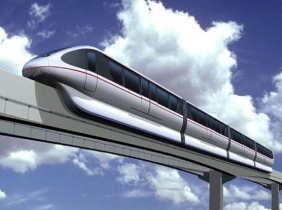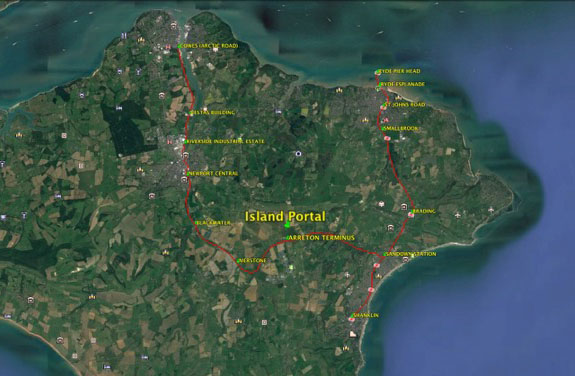Transportation
The Isle of Wight had, in its glory days a steam train rail track that powered transport for people and goods around the Island without the use of vehicles. To this day, this pathway has been preserved and turned into a cycle track from the outskirts of Cowes to the outskirts of Sandown. It is possible to install a Monorail system above the cycleway that it has become, whilst maintaining the present Cycle Paths. The train line that is active at the moment from Shanklin to Ryde has not been invested in for a great many years. New trains and possibly even track will need to be updated or renewed very soon. This plan will undertake to remove traditional standard gauge trains (which are environmentally unfriendly) and all of the track and sleepers to create a new cycleway from Shanklin to Ryde. Just as the Monorail will be above the cycle track from Cowes to Newport and then on to Sandown, a Monorail will be installed above the new cycle way from Shanklin to the end of Ryde pier. Both sections of Monorail will join at Sandown to form a loop.
The Electric Monorail System

This will facilitate the use of the monorail for commuting from town to town of the major populated five areas of the Island by Island Residents. Tourists or business people arriving from the Mainland will therefore not be required to bring a vehicle if they need to visit these major towns Reducing both Carbon emissions and Traffic congestion. School children will also be able to reach their destination in the morning, and return home in the afternoon easily and in comfort. The festivals will be well catered for as coaches and cars will not necessarily be required. The monorail system will travel through the most glorious countryside making each journey a pleasure just as it did in the days of the steam trains. Vehicle usage will be kept to a minimum if travelling between these towns. It will be possible to enter the monorail at Cowes, transfer to the traditional standard gauge train at Arreton and be at the airports of Gatwick or Heathrow some 90 minutes later. A single line monorail system will be installed. Each station will have holding bays for two Monorail trains. A timed system also using a global positioning system will ensure that the trains will pass each other whilst the other one is at a Station in a holding bay. Therefore a single line monorail system can be used for trains going in different directions without fluidity of motion being compromised. In order to choose your direction of travel, you will enter the train that is going in your direction on one side of the station platform or the other. In effect one train will continue in a loop from Cowes to Ryde and then from Ryde to Shanklin and then from Shanklin to Cowes.Enter your text here

Monorail Station Locations
It is envisaged a monorail will begin at:
1/Arctic Road....Cowes Station.
3000metres 120kph
to:
2/The present Vestas building.
1500 metres. 60 kmkph
to:
3/Riverside industrial Estate next to veterinary surgery on vacant ground between National cycle route 23 and public footpath N29. Will serve the hospital and IOW college also.
1600 metres. 64kph
to:
4/Newport Central Station will be on land vacant between St Georges approach, Saint Georges Way and Connies Way footpath.
2400 metres 96kph
to:
5/Blackwater station.
2900 metres. 116kph
to:
6/Merstone Station
3300 metres. 132kph
to:
7/Arreton Terminus / Mainline train station and vehicle portal.
2400 metres. 96kph
to:
8/Alverstone garden village.
2400 metres. 96kph
to:
9/Sandown Station.
Then to:
2400 metres 96kph
to:
10/Brading station
4000 metres. 160kph
to:
11/ Smallbrook Station
1200 metres. 48kph
to:
12/ St. John's Road Station
1900 metres. 76kph
to:
13/ Ryde Esplanade
600 metres. 24kph
to:
14/ Ryde Pier Head) Three holding bays are required at Ryde Pier head. One train with carriages will always be ready to load from the passenger ferry. This will ensure the fluidity of motion as the trains revert one place back at this position. I.e. One train out as one arrives but one is also loading at the same time.
Sandown to Shanklin is 3300 metres. 132kph

COWES - NEWPORT CENTRAL. 6.42KM
NEWPORT CENTRAL - SANDOWN. 13.5KM
SANDOWN - SHANKLIN. 3.51KM
SANDOWN - RYDE P/HEAD. 9.89KM
TOTAL REQUIRED 33.32KM
There is potential scope to add Stations at East Cowes via a bridge to Brittania Way. This bridge could easily have a hinged rail to allow for oversized vessels. Wroxall and Ventnor could potentially be reached via the original Steam Train track. Also another station at Lake could be added for Tourist easy beach access.
The time allocated at each station for disembarkation and embarkation will be 50 seconds. Each journey between stations will take 90 seconds, with an added 10 seconds for inertia and another 10 seconds for breaking. So it will take 110 seconds between stations. A journey between Cowes and Sandown is eight stations and eight stops which means a journey time of 21 minutes and 33 seconds. This will be quicker than a vehicle and is far more ecologically friendly and is more enjoyable as you travel through beautiful scenery. We believe tourists will come to the island on the train to experience our ground-breaking Monorail system and then hire a bicycle and cycle the route afterwards.
With full train capacity the maximum wait time between trains should be no more than 2 minutes and 40 seconds. As you remove trains from operation due to lack of passenger requirement, the regularity will decrease but still anticipated to be no longer than 10 minutes.
What happens to the Ferries?
The Yarmouth to Lymington Ferry car ferry would stay. Those who prefer this mode of transport will still have that option and West Wight will still be connected to the New Forest. The ferries that service this route have been renewed recently. Yarmouth town thrives on tourism coming from the ferry route and people commuting to Lymington or surrounding areas will require the ferry service to remain.
The red Jet passenger ferry from Cowes to Southampton Town Quay will also remain as this is vital for those in Cowes to commute to Southampton and also for sailors to gain access to Cowes. This service is not labour intensive and is profitable and takes very little space.
The fast cat passenger ferry from Portsmouth to Ryde pierhead will also remain and will link up with the new monorail system on the Island as well as the link to the trains at Portsmouth harbour.
It is envisaged that the hovercraft at Ryde Sands (Hover travel) will continue but it remains to be seen whether it will be used profitably as people make different choices of transport. This form of transport is notoriously uneconomical and environmentally unfriendly although great fun.
It is anticipated that the Wightlink Fishbourne to Portsmouth Car ferry service will be discontinued. The existing ferries are requiring replacement as existing ones are proven unreliable. This has an estimated cost to the taxpayer of around £200 million. The Wightlink company are already reputedly £200 million in debt. Valuable land at both locations on the Isle of Wight and Portsmouth will be freed up for alternative use or possibly sold to pay creditors.
It is anticipated that the Red funnel Car ferry from East Cowes to Southampton will be discontinued. East Cowes is set to be regenerated as soon as the new sea defence system for Cowes Harbour has settled. It is envisaged a new marina complex inside East Cowes breakwater will be built and the car ferry movements will no longer need to be taken into consideration. The land which is used for bottleneck traffic storage while loading and unloading the car ferry at East Cowes will be freed up for alternative use. At Southampton the regeneration of the Town Quay and Mayflower Park area is to include a new berth for the Red funnel car ferry. The Red funnel ferry company are reputedly also £80 million in debt. £40 million of taxpayers money has reputedly recently been allocated to help settle their debts. It is envisaged that it will also be the taxpayer who pays for the relocation of the berthing for the Red funnel ferry at Southampton within the regeneration plans. Tax payers money saved through the removal of the necessity to pay for this berth can be allocated to assist with payments of the fixed link.






